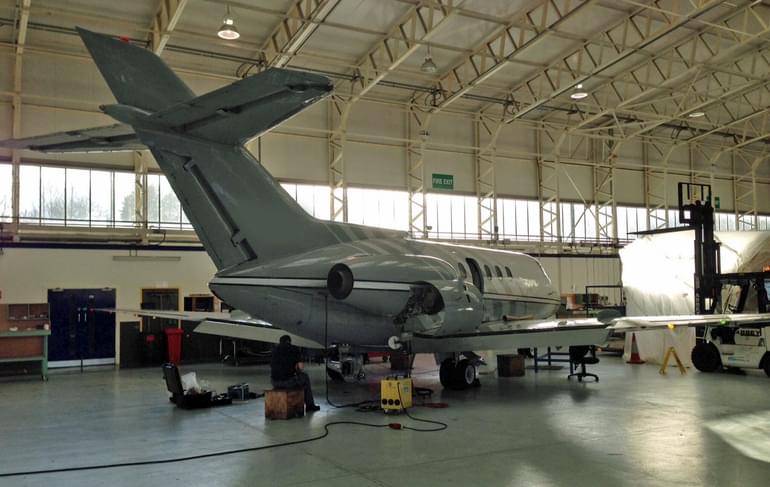Taking control of aircraft under a High Court writ
By David Asker on
This article gives an insight into the process of seizing aircraft and the steps that need to be taken by leasing companies, banks, co-owners, MROs, and Continuing Airworthiness Management Organisations (CAMOs), to ensure they avoid the pitfalls of the process.

As part of my working life as a High Court Enforcement Officer (HCEO) I seize aircraft. It can be a tricky business, and there’s no shortage of paperwork and procedures, but it does make for an exciting day out!
There are various reasons why the aircraft might be seized - perhaps the owner has stopped finance payments, or the engines need to be recovered at the end of the lease, or the plane is a high value asset being seized to pay off a debt.
On one occasion, our client had won their case in court and the plan was to take control of a business jet belonging to the defendant when it next flew into the UK. I have access to a number of sources that let me know when specific aircraft are headed into the country.
So, in this case, having received the writ of control that would empower me to seize the aircraft, I attended before a Master in the High Court to obtain an order to support executing the writ, and, while I was in the corridor outside, I received a text to say this plane was inbound that very evening to a business airport in southern England.
As soon as I got the order signed and sealed, I made for the next available train and put the operational plan into force. As I travelled with the arrival imminent, the team was put in place, the logistics finalised, including checking the ownership of the specific aircraft that was due to land, in order to check whether there were mortgages or other financial arrangements that might affect the seizure and sale of the aircraft, and getting secure storage and maintenance ready.
You absolutely have to have a full operational plan and insurance in place before you go airside, as when dealing with any high value asset - these do also tend to be high maintenance items!
As the plane came in on its final approach, I was working with the duty controller at the airport to get the plane unloaded and moved to a location where we could complete the seizure, but without alerting the pilot to our presence beforehand. Tell the pilot to disperse his aircraft over in the “boondocks” at the edge of the airfield and he’ll get suspicious that something is afoot and may even abort the landing to go elsewhere.
As soon as the pilot had finished taxiing, we got the passengers and crew off safely, boarded the aircraft, then formally tool control of it with the notices of control prominently displayed. This made it very clear that the aircraft was now under my control (in my capacity as an authorised HCEO) and that it is a criminal offence to move or interfere with it.
When taking control of an aircraft, I sometimes request support from the Police, particularly if there could be resistance from the crew or ground crew, or there if there might be air marshalls on board. It is a criminal offence to obstruct me executing a High Court writ, but that doesn’t always stop people from trying!
Because we often don’t know who will be on the plane, we sometimes have the UK Border Agency with us to check the passengers. On one occasion I seized a plane with over 20 unaccompanied minors on board: we certainly needed the support we got from the local Social Services. There can also be VIPs on board, so discretion has been necessary on occasion to prevent a diplomatic incident!
Then the negotiations start.
If the aircraft or engines are being recovered on behalf of a leasing company, the seizure will have been done under a writ of delivery, which instructs the HCEO to recover the actual goods, rather than seek payment, so it is then a case of securely storing the plane when the necessary paperwork is completed and a crew is brought in to transfer the plane to another location.
In the case of money judgments when acting under a writ of control, regardless of whether the original judgment was awarded in the UK or overseas, the aircraft is being held as an asset that can be sold to recover the debt. In practice, the owner/airline will normally negotiate payment terms, so that they can get their plane back into operational fee-earning service as quickly as possible.
I am responsible for looking after the seized aircraft properly; if negotiations take time, then I may have to arrange for secure storage and for maintenance plans to continue: this might extend to hiring a scratch crew to moving the plane to an alternative location, possibly even to another airport if parking at the airport you are at is restricted or is very expensive.
I have even had occasions when the aircraft was due for scheduled maintenance, so have had to arrange that and get a type qualified and insured maintenance organisation in to undertake this. It’s a criminal offence to work on a plane unless you are qualified and insured to do so.
Most often negotiations are successful, but there are occasions when the aircraft is sold. We will need to get the full certification suite and also the maintenance records, sometimes from an independent CAMO (Continuing Airworthiness Management Organisation) – which can be particularly easy if they are the creditor we are acting for!
In the case of a UK registered aircraft, we will contact the CAA (Civil Aviation Authority) who will deregister it and register it with the new owner. In the case of a foreign aircraft, we will work with a specialist broker to achieve this. Where there are multiple owners, the case will almost certainly go to court, but it would be unlikely that the owners would be able to prevent the sale.
If the aircraft in not airworthy, for example maintenance may be incomplete, then it may be sold for parts. Here again, the full technical log will be required.
As I mentioned earlier, the actual seizure is a case of being properly prepared in advance, knowing when the aircraft will be arriving and moving quickly to be in the right place at the right time.
There is a great deal to know and get right from the aviation perspective – insurance, permits, experienced enforcement personnel, flight and maintenance crew, knowing who to talk to and when.
There is also everything that I need to know as an HCEO – the regulations, procedures and processes, as well as which High Court Master we can access out of hours to get the writ at short notice if I need to, as well as permission to waive the requirement to give advance notice of our attendance!
Our clients come from all over the world – CAMOs, MROs (Maintenance & Repair Organisations), leasing companies, banks and co-owners, to mention just a few. Sometimes they come to us directly, sometimes via their law firm.
High Court writs are pretty powerful – once we have the writ, whether a writ of delivery to recover specific items or a writ of control for money, the goods are under our control and may not be disposed of. It’s often known as protective distraint.
The court fees are added to the sum recoverable from the defendant. If it is a money claim, judgment interest is also recoverable.
Article originally published in Aviation Finance Magazine.

David Asker
David is an authorised High Court Enforcement Officer and our Director of Corporate Governance
